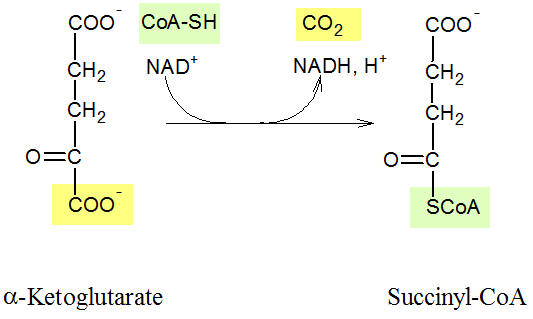Krebs cycle step 4
From Proteopedia
(Difference between revisions)
m (Sandbox Oldenburg07 moved to Krebs cycle step 4) |
|||
| Line 1: | Line 1: | ||
| - | <h2>Step four of the Krebs Cycle: α- | + | <h2>Step four of the Krebs Cycle: α-Ketoglutarate Dehydrogenase</h2> |
[[Image:ketoglutarate.jpg]] | [[Image:ketoglutarate.jpg]] | ||
<p>Figure: Formation of succinyl-CoA | <p>Figure: Formation of succinyl-CoA | ||
| - | + | In the fourth reaction of the citric acid cycle, an oxidative decarboxylation takes place. This means that again a CO<sub>2</sub> molecule is relased (decarboxylation) and that an odixation takes place. In this case, the carbon atom that will form CO<sub>2</sub> is oxidised. Furthermore, an energy-rich coenzyme A molecule (green background) is added so that | |
succinyl-CoA is formed. At the end of this reaction, we get a C4 body.</p> | succinyl-CoA is formed. At the end of this reaction, we get a C4 body.</p> | ||
Revision as of 09:05, 29 December 2014
Step four of the Krebs Cycle: α-Ketoglutarate Dehydrogenase
Figure: Formation of succinyl-CoA In the fourth reaction of the citric acid cycle, an oxidative decarboxylation takes place. This means that again a CO2 molecule is relased (decarboxylation) and that an odixation takes place. In this case, the carbon atom that will form CO2 is oxidised. Furthermore, an energy-rich coenzyme A molecule (green background) is added so that succinyl-CoA is formed. At the end of this reaction, we get a C4 body.
Proteopedia Page Contributors and Editors (what is this?)
Verena Pietzner, Michal Harel, Alexander Berchansky, Jaime Prilusky

